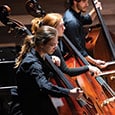Instrumentalists usually can divide their tasks while playing into technical or musical categories. For example, developing agility with alternate fingerings on a saxophone and legato tonguing on a trombone are mostly technical exercises, especially at first. Choosing a peak for a phrase and deciding how to approach it is more of a musical task. However, as musicians mature, the line between musical and technical blurs; incorporating alternate fingerings or legato tonguing to make a phrase sound exactly as desired is both technical and musical. Percussion stickings can be a crucial component of both technical and musical decisions.
The default sticking for most percussion playing is alternating right-left-right-left. This pattern tends to provide the most balanced, even, and steady strokes for general playing. However, players can alter this sticking in many ways, incorporating two, three, or more strokes on one hand at any given point in a pattern, such as R-L-L-L-R-L-L-L. Varying the pattern sparks an automatic shift in technical execution, resulting in a subtle change to the sound. Seasoned percussionists choose stickings wisely, based on technical necessity, musical preference, or both.
Pulse
Perhaps the most common detour from alternating sticking is right-hand or left-hand lead. The example below shows right-hand lead sticking. The right hand plays all of the main divisions of the beat, while the left hand fills in any subdivision notes. Left-hand lead sticking is exactly the same, except that the pattern is reversed. In either case, maintaining consistent divisions of the beat on one hand helps to maintain pulse integrity and consistency. The lead hand is able to establish a constant repetitive pattern, while the other hand executes the changing subdivisions, creating a physical pivot point for the player.
.jpg)
Note that playing this passage with purely alternating sticking would cause the pulse to shift back and forth between the hands, due to even or odd groupings of notes. This shifting can cause a student’s internal pulse, and resultant sound, to waver.
Instructors can coach development of lead-sticking technique by having students play constant eighth notes in one hand, while varying the subdivisions at will in the other hand. The instructor and students can play the eighth notes together, and take turns supplying improvised sixteenth note patterns. Instructors should create the subdivision variations at first while students copy, and then students can begin to create their own. This approach builds confidence in the technique, and helps to solidify rhythm and sticking vocabulary without the complication of notation. Once students are confident with the technique, they can be coached through notated rhythmic passages, to choose appropriate places to apply it.
Rhythmic Phrasing
Besides strengthening a sense of pulse, one-hand lead can help to create confident and comfortable rhythmic phrasing. Students will be less likely to trip over shifting stickings, thus helping them to maintain focus on shaping the rhythmic phrase as they intend it. Other variations of stickings can also be helpful for rhythmic phrasing, each depending on specific musical situations.
Slow tempos, for example, can be especially troublesome for percussionists. In addition to standard methods of maintaining slower tempos, such as working with a metronome, counting subdivisions, or focusing on the offbeat, percussionists may benefit from exploring sticking possibilities as well.
.jpg)
The phrase above moves rather slowly, and the usual tendency would be to push the eighth notes, especially if using alternating stickings. If a student plays all the notes with one hand instead, that hand moves twice as fast as it would with alternating sticking, essentially cutting in half the tendency to accelerate. Equally as important as the improved tempo control, the student will likely be able to manage the gradual dynamic curve more effectively.
Rhythmic phrasing should not be defined simply as producing an acceptable pulse, placement, and shape, but also in terms of creating just the right nuance for a given passage. Below, two sticking possibilities are provided. Each of these would create different nuance within the phrase. Students should consider how to group notes and relate them to the larger phrase; choice of sticking can be a great way to project these decisions.
.jpg)
Melodic Phrasing
Melodic phrasing on any instrument requires fusing internal sound concept and technical facility. Each instrument carries its own set of idiomatic technical challenges. For example, clarinetists must be able to play smoothly over the break, and violinists must be able to shift positions seamlessly. In the percussion family, the layout of mallet keyboard instruments requires players to consider how to move fluidly around the keys. Stickings are a key approach to phrasing well.
All sticking options discussed so far generally apply to mallet keyboard playing as well. Alternating as the default; one-hand lead for consistency; and various combinations of singles, doubles, triples, or more can all be used to produce the desired phrasing. Keyboard instruments also require players to consider sticking options for facility of lateral movement in otherwise standard situations.
This example is probably suited to alternate sticking, beginning with the left hand.

However, this passage, because of the pattern shift, would create an awkward physical motion with alternating sticking. Therefore, the sticking shown might be more beneficial. Experimenting with multiple possibilities will help instructors and students find the smoothest path to the desired musical result.

Keeping the mallets out of each other’s way, as shown in the above sticking suggestion, is an extremely important technical strategy in keyboard percussion phrasing. This can be helpful when playing notes in the top and bottom of the range as well, to avoid crossing one arm unnecessarily over another. Keyboard percussionists can also vary stickings when playing a linear phrase, to smooth potentially disjointed playing between the natural keys and the sharp/flat keys.
.jpg)
Given the key signature, alternating sticking would introduce excess lateral motion in this passage on the xylophone. At a quick tempo, economy of motion is a priority; the suggested sticking is one way to produce it.
Fluidity on Multiple Drums
Strategies for lateral movement across the keyboard instruments are equally important for phrasing on timpani, drumset, marching tenors, and any multiple percussion setup. Regardless of complexity, producing rhythms across multiple surfaces requires the player to consider and reconsider how best to progress from one drum to the next and achieve the desired musical result.
In this simple rhythmic passage the difficulty comes from making the groups of notes sound smooth and connected between the drums.
.jpg)
Alternating sticking would require students to cross one hand over the other, or shift one hand quickly out of the way of the other, likely producing an unwanted accent. To overcome this challenge, a student can introduce a double into each group of 16th notes (RLRR-LRLL, or RRLR-LLRL) to give the switching hand a bit of extra time and space. This makes it easier to switch drums and improves musicality.
On the drumset, similar considerations apply. For example, in any style incorporating swung eighth notes (jazz, country and western, boogie-woogie, blues), the underlying beat divisions are groups of three. To move comfortably around the kit while playing a fill in these styles, creative stickings can improve technical facility and musical phrasing. In the example below, alternating sticking would create physical confusion as the arms attempt to get out of each other’s way. However, using a RLL sticking throughout makes the passage a strikingly easy task and also contributes to the natural lilt of three-based rhythms.
.jpg)
Concluding Thoughts
Helping students develop confidence and consistency with alternating sticking is an important aspect of percussion instruction. However, students should learn and practice a variety of sticking possibilities as well. Helping percussion students develop a repertoire of stickings and a solid understanding of when to use them will go a long way in improving their interpretative abilities and resultant sound.





